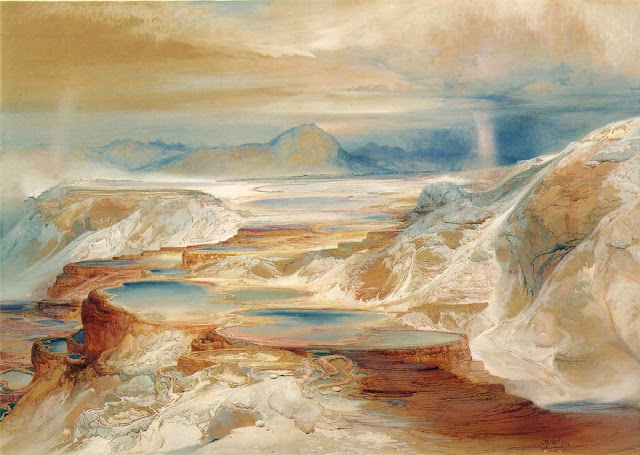Moran along with Albert Bierstadt, Thomas Hill, and William Keith are sometimes referred to as belonging to the Rocky Mountain School of landscape painters because of all of the Western landscapes made by this group.
This is part 2 of a 5-part post on the works on the works of Thomas Moran.
Works appear chronologically, but a number of undated works will be in part 5. For biographical notes on Moran see part 1.
 |
| 1871 Gardiner River, Liberty Cap |
 |
| 1871 Grand Canyon of the Yellowstone |
 |
| 1871 Great Springs of the Firehole River |
 |
| 1871 Hot Springs of Gardiner River |
 |
| 1871 In the Grand Canyon |
 |
| 1871 Liberty Cap, Clematis Gulch |
 |
| 1871 Sand in the Canyon watercolour 14.6 x 25.2 cm |
 |
| 1871 The Devil's Slide, Yellowstone watercolour 26 x 17.8 cm |
 |
| 1871 Tower Creek watercolour 19.7 x 26.8 cm |
 |
| 1871 Tower Falls |
 |
| 1871 Upper Falls, Yellowstone watercolour on paper |
 |
| 1871 Yellowstone Canyon |
 |
| c1871 Great Springs of the Firehole River watercolour 20.6 x 28.3 cm |
 |
| 1872 Above Tower Falls, Yellowstone watercolour, gouache on paper 38.1 x 26.7 cm |
 |
| 1872 Big Springs in Yellowstone Park watercolour 23.5 x 48.9 cm |
 |
| 1872 Cliffs of the Rio Virgin, South Utah watercolour |
 |
| 1872 Cliffs, Green River, Wyoming watercolour 15.2 x 27.9 cm |
 |
| 1872 Hot Springs of Gardiner's River watercolour 51.4 x 72.7 cm |
 |
| 1872 Hot Springs of the Yellowstone oil on canvas 41.1 x 76.2 cm |
 |
| 1872 Mammoth Hot Springs, Yellowstone watercolour on paper 36.3 x 26.4 cm |
 |
| 1872 The Devil's Den on Cascade Creek watercolour 33.3 x 24.5 cm |
 |
| 1872 The Grand Canyon of the Yellowstone watercolour 28.6 x 20.3 cm |
 |
| 1872 The Great Hot Springs, Gardiners River watercolour 21.9 x 44.8 cm |
 |
| 1872 The Hot Springs of Gardiners River, Upper Pools watercolour 29.8 x 21.6 cm |
 |
| 1872 Tower Falls and Sulphur Mountain, Yellowstone watercolour 24.1 x 33.7 cm |
 |
| 1872 Tower Falls watercolour |
 |
| 1872 Wyoming Fall, Yellowstone River watercolour 33 x 44.4 cm |
 |
| c1872-75 Summit of the Sierras gouache on paper 36 x 25 cm |
 |
| 1873 Cliffs of the Rio Virgin, South Utah watercolour |









+oil+on+canvas+74.9+x+113+cm.jpg)







+oil+on+canvas+101.6+x+87+cm.jpg)













